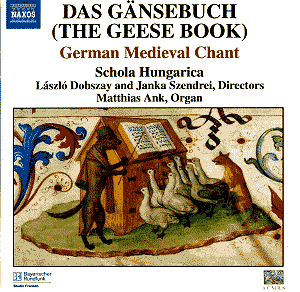Soon after its foundation
in 1050 the South-German city of Nuremberg
developed into an important international
trade centre. In 1530, the German reformer
Martin Luther wrote: "Nuremberg truly
shines in Germany like a sun among the
moon and stars". And in the 18th century
the city was called a "spider in the
web" as it was located at the intersection
of trade routes between the German-speaking
world, Eastern Europe and the Mediterranean
region. Usually affluence meant a large
amount of independence, not only in
political but also in religious matters.
Nuremberg was part of the diocese of
Bamberg and had to follow the liturgy
as practised in Bamberg Cathedral. The
churches in Nuremberg nevertheless developed
their own liturgical habits, for example
in regard to the choice of feast days.
At the beginning of the 16th century
the parish of St Lorenz commissioned
a Gradual, to contain the music for
the Mass liturgy. It was published in
two volumes in 1507 and 1510. It wasn't
used for long, because in 1524 the city
joined the Lutheran Reformation.
The wealth of the city
was also reflected in the publication
itself. It contained many elaborate
decorations. One of these was the illumination
for the Feast of Ascension, showing
a choir of geese directed by a wolf,
dressed as cantor. Hence the nickname
of the collection, 'Das Gänsebuch'
(The Geese Book). "The Geese Book with
a total of 1120 pages is the only complete
extant source for the pre-Reformation
liturgy of the Mass in Nuremberg and
preserves the music of one of the most
prominent city parish churches of the
empire", according to the programme
notes. This disc therefore only contains
a small selection from the chants in
the manuscript. It concentrates on those
masses which are connected in one way
or another to Nuremberg. We find masses
for Saint Sebaldus and Saint Lawrence,
those saints who have given their name
to the most important churches in the
city, St Sebaldus and St Lorenz. As
only the propers of the mass are directly
connected to specific feast days, only
these are recorded here.
From 1424 until 1524
the main feast day in Nuremberg was
the Feast of the Holy Lance and Nails,
better known as 'Heiltumsweisung'. It
was celebrated at the second Friday
after Easter, when a collection of sacred
objects (relics and regalia) which were
mainly assembled by Emperor Charles
IV, were displayed at the main market
of Nuremberg. The singing of the Missa
Lancea Christi et armorum domini (Lance
of Christ and arms of the Lord) was
sung as part of the ritual connected
to the celebrations. Saint Deocarus,
to whom another Mass was devoted, was
one of the city's patrons, whose relics
were preserved in St Lorenz in a shrine,
which was carried in a procession around
the church on 7 June.
The vocal items are
interspersed with organ pieces, some
of them by the most famous organists
of the 15th and early 16th centuries,
Hans Kotter, Conrad Paumann and Arnolt
Schlick.
The Schola Hungarica
contains a mixture of children's and
adult voices, both male and female.
No doubt this is an excellent choir,
one of many in Hungary. During the past
decades it has made a large number of
fine recordings with liturgical repertoire
from Hungarian and other sources, showing
the variety in liturgical practices
from one country or region to another.
There are some question
marks in regard to the number of singers
involved, as it isn't very likely the
repertoire on this disc was originally
sung by a choir of this size - 36 names
are listed in the booklet. And the singers
were certainly all male; not the case
here where perhaps the majority of the
singers are female. This doesn't take
anything away from the quality of the
performances. The choir produces a beautiful
sound and brings stylish interpretations
of this interesting liturgical repertoire,
most of which are recorded here for
the first time.
Considering the historical
importance of this repertoire and the
quality of both music and performance
I recommend this disc to anyone interested
in liturgical music.
Johan van Veen


